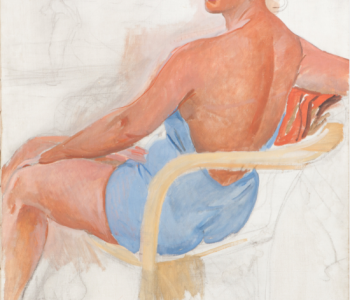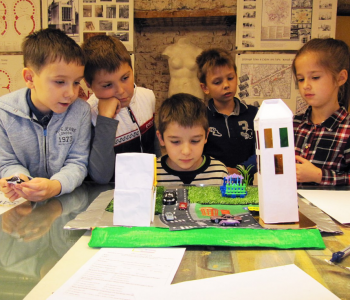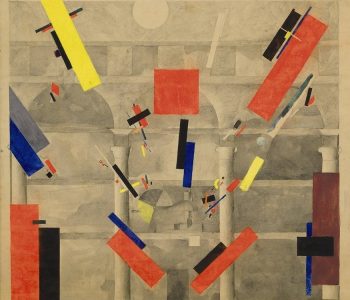

Muar (so familiar in Moscow called the Museum of architecture named after Shchusev) can hardly be called a Museum in the usual sense of the word. Is it possible within the walls of one building to collect and preserve the streets and the facades of the houses? In the drawings is probably. This is the uniqueness of the MUAR: it is not only a museum of architectural history, although historical documents in its files (layouts, measurements, drawings) tens of thousands, and not just the keeper of antiquities, housed in a historic mansion. No other museum where the exposure changed as often as here. The reasons for this dynamic somewhat.
Firstly, the museum is so large and diverse that exhibit it a little, parts and not in all rooms, creating from each show separate information about. In one season all of the competition for Lenin's Mausoleum, the other with the pre-Napoleonic model of the Kreml Palace. All winter can exhibit works of students of VKHUTEMAS, and then – contemporary Austrian art. It would seem that such a policy could not be long, but the Museum has adhered to it for more than fifty years and yet never repeated.
A. V. Shchusev (1873 – 1949) was a famous Russian architect, the founder of the Museum of Russian architecture. Among his creations of world importance are the Lenin mausoleum, Kazan railway station, the hotel "Moscow".
Secondly, since the architecture is committed to keeping pace with the times, this area should follow and architectural Museum. Play the role of a research centre, to arrange debates, meetings, historical lectures on architecture is especially important in Moscow, the city where one architectural style piled on top of the other and replaced by the following. The architecture is happy due to its specialization is not restricted to meetings in the lecture hall, and to take them for a stroll around the city.
Thirdly, is increasingly establishing itself as the center of a network of specialized museums United by a common cultural objectives, Muar actively travels with exhibitions, showing how easily he can adapt to any spaces, halls and galleries. The very beginning of its exhibition activities, the Museum connects with the opening of the exhibition in the Upper gallery of the Great Cathedral of the Donskoy monastery in 1936. The exhibition was dedicated to the Russian classicism in architecture and lasted until the end of 30-ies. The Museum organized the exhibition under the open sky in the Donskoy monastery, the whole territory which was occupied by sculptures and fragments of destroyed buildings and ancient bas-reliefs. In the postwar years, the Museum continued to organize exhibitions under the open sky, for example, in a Moscow Park "Sokolniki", directing the funds to the restoration of the destroyed during the war of the cities. Reenactment activities became the main focus of the architectural Museum in the postwar period.
The Museum exhibition halls: Enfilade, Outhouse "Ruin", the pharmaceutical order.
Muar continues to hold a popular exhibitions in different cities and countries. The private exhibition halls, the museum is not limited to the capabilities of the vaults. Every season in the museum are represented by Russian and foreign artists and architects as the legendary, and very young. Only recently visited the works of Oscar Niemeyer, Alessandro Papetti, Alexander Brodsky, Tonino Guerra. Recently here in the hall "Ruin", was held the famous exhibition of Nikolay Lyovochkin, which demonstrates the policy of the museum of architecture for the maintenance and discovery of new and unusual phenomena. Nicholas Lyovochkin, a brilliant Russian self-taught, most of his life working as a machinist in the Moscow metro, became famous only after death, when the family opened to the world, his legacy. In the apartment of a former machinist relatives, to his surprise, found microgarden assembled from different materials. Stylized ancient temples and houses were going wonderful architect from pieces of furniture, bottles, planks, or rails scraps. The find was given to the museum and then immediately presented to the public.
Genius loci
Special attention deserves a place in Vozdvizhenka street, where the Museum is located. It's not just that from his end Windows offer a wonderful view of the Kremlin, in particular, at Trinity tower and the bell tower of Ivan the Great, although in many respects close proximity to the Kremlin and made this place unique. The history of this land speaks for itself.
Apothecary order
In the early seventeenth century there was a farmstead of the Pskov – caves monastery, but by the middle of the century the land passed into the possession of the boyar Miloslavsky, I. D., next of kin Tsar Alexei Mikhailovich. In imitation of the king Miloslavsky broke Botanical garden and herb garden between the Borovitsky gate and the banks of the Moscow river – that is where today the beginning of a Large Stone bridge and the government's entrance into the Kreml. Apothecary at Miloslavsky went wrong and greatly enriched the Royal Treasury, so that by 1660 years was built a complex of farm buildings Aptekarsky yard, instead of the ones that lived near the Troitskaya tower. From those times have survived "chamber for feeding" the refectory at three cellars, adapted to the exhibition space.
Talyzin Manor
At the end of the XVIII century apothecaries ' offices were moved in another place, and the vacant plot of land passed from one wealthy owner to another. It is known that at one time the territory belonged to Prince V. L. Dolgoruky, then a Georgian Prince Vakhtang. Since the end of XVIII century noble family settles Talyzins in which and formed the architectural ensemble of the estate, still bearing the name of this genus.
Offices of Stalin and Molotov
As we see the mansion now, she was in the second half of the nineteenth century, after it was sold to the exchequer. After the revolution, all the possessions of the Treasury were nationalized in 1920 so well located to the manor for four years took the party apparatus – the Secretariat of the Central Committee of the RCP(b). The offices of the secretaries of the Central Committee of I. V. Stalin and V. M. Molotov was in the main building of the estate. There, on the second floor, in the hall with columns, kept secret documents.
The hostel
In 1930, the mansion was given over to the dormitory in which lived more than 800 people. Spacious rooms divided by plywood walls in living rooms. Remodeling under the "Dorm" and 15 years of its existence has caused irreparable damage to the estate. After the war, when the building passed into the possession of the Museum, began a large-scale, which took almost 20 years, restoration.
Donskoy monastery
In 1934 on the initiative of A. V. Shchusev and his supporters, the Museum has an official status: it became one of the divisions of the Academy of architecture. After a year the needs of the new Museum was given to the Donskoy monastery, in fact, saved from demolition and preserved to this day. In the 1930-ies in the territory of the monastery were brought together surviving fragments of destroyed churches in Moscow: the assumption on Pokrovka, Nikola in the Pillars, reliefs of the temple of Christ the Savior, a fragment of the Sukharev tower, and part of the decoration of the triumphal arch, standing on the triumphal square.
In 1991 the monastery was returned to the Russian Orthodox Church, and the Foundation of the Muar completely moved on Vozdvizhenka. But the famous sculpture and remained in the monastery and exhibited under the open sky.
A. V. Shchusev and the creation Museum
Prominent architect throughout his life fought for the ability to create a universal Museum of architecture. The first attempts were made in the early 1920-ies, when there was a need to preserve and restore the precious surviving fragments of old architecture. Shchusev understand the wider objectives and together with colleagues has developed "regulations on the Museum", in which the Museum of architecture was to perform an educational function and provide the room "to practice everyone interested in architecture." Own building has been obtained only in 1935.
After the war it became apparent the need to expand the activities of the Museum for the conservation and restoration of national heritage. The initiative for the revival of the architecture of cities was supported by the government, and in 1945 Talyzin manor was given to the organization of the new museum of Russian architecture.
In 1963, after the death Shchusev, there was an Association of two museums: the Scientific-research museum of the Academy of architecture (Donskoy monastery) and the State museum of Russian architecture (Talyzin manor).
Working hours:
Tue – Sun: 11.00 – 19.00
Thursday: 13.00 – 21.00
Day-off: Monday
The ticket office closes 30 minutes before the end of the work.
Dear friends, pay your attention, to the fact that the time and days of work of "State Museum of architecture named after Schusev" can change, so before visiting it we recommend you to call: +7 (495) 691 – 21 – 09.








